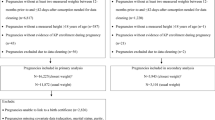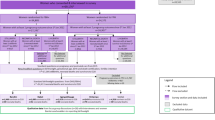Abstract
To evaluate the utility of maternal recalled birth size (BS) as a proxy measure for actual birth weight (BW) when BW data are missing. Data for the study come from the 2000 National Health Survey of Oman. Frequency distribution, sensitivity and specificity analysis, bivariate, and multivariate statistical techniques were used for data analysis. The BW data exhibited a moderate level of heaping on measurements ending in 0 or 5, suggesting that health personnel often round when recording. About 31 % of actual BW data were missing due to non-availability of health cards. Maternal assessment of BS was found to be closely linked to BW on an aggregate level. However, on an individual level, there was misclassification of birth weights across all categories of BS. The overall agreement between recalled BS and recorded BW was moderate (κ = 0.44). Infants with missing BW records were more likely to be low birth weight (LBW). Maternal recalled BS appeared to be a poor proxy for BW. Estimates of LBW based on maternal assessments of BS as small should be considered as an underestimate of its actual prevalence. As infants with missing BW data have different characteristics from those with recorded BW, estimates of LBW depending solely on available BW records will produce a biased prevalence. Health personnel should record actual BW without rounding. They should inform mothers of the birth weight and advise them to retain health cards for future reference.


Similar content being viewed by others
References
McCormick, M. (1985). The contribution of low birth weight to infant mortality and childhood morbidity. New England Journal of Medicine, 312, 82–90.
Kramer, M. S. (1987). Determinants of low birth weight: Methodological assessment and meta-analysis. Bulletin of the World Health Organization, 65, 663–737.
Millman, S. R., & Cooksey, E. C. (1987). Birth weight and the effects of birth spacing and breastfeeding on infant mortality. Studies in Family Planning, 18, 202–212.
Abell, T. (1992). Low birth weight, intrauterine growth-retarded, and pre-term infants. Human Nature, 3, 335–378.
Wardlaw, T., Blanc, A., Zupan, J., & Ahman, A. (2004). Low birthweight: Country, regional and global estimates. New York, Geneva: United Nations Children’s Fund (UNICEF), WHO.
World Health Organization (WHO). (1992). Low birth weight: A tabulation of available information, WHO/MCH/92.2. Geneva, New York: World Health Organization, UNICEF.
Kliegman, R. M., Rottman, C. J., & Behrman, R. E. (1990). Strategies for the prevention of low birthweight. American Journal of Obstetrics and Gynecology, 162, 1073–1083.
Villar, J., & Belizan, J. M. (1982). The relative contribution of prematurity and fetal growth retardation to low birth weight in developing countries and developed societies. American Journal of Obstetrics and Gynecology, 143, 793–798.
United Nations (UN). (2002). Resolution adopted by the General Assembly, Twenty-seventh special session, S-27/2. New York: A world fit for children.
Channon, A. A. R., Padmadas, S. S., & McDonald, J. W. (2011). Measuring birth weight in developing countries: Does the method of reporting in retrospective surveys matter? Maternal and Child Health Journal, 15, 12–18.
Moreno, L., & Goldman, N. (1990). An assessment of survey data on birth weight. Social Science and Medicine, 31, 491–500.
Boerma, J. T., Weinstein, K. I., Rutstein, S. O., & Sommerfelt, A. E. (1996). Data on birth weight in developing countries: Can surveys help? Bulletin of the World Health Organisation, 74, 209–216.
Eggleston, E., Tsui, A. O., & Fortney, J. (2000). Assessing survey measures of infant birth weight and birth size in Ecuador. Journal of Biosocial Science, 32, 373–382.
Joffe, M., & Grisso, J. (1985). Comparison of antenatal hospital records with retrospective interviewing. Journal of Biosocial Science, 17, 113–117.
Blanc, A., & Wardlaw, T. (2005). Monitoring low birth weight: An evaluation of international estimates and an updated estimation procedure. Bulletin of the World Health Organization, 83, 178–185.
Channon, A. A. R. (2011). Can mothers Judge the size of their newborn? Assessing the determinants of a mother’s perception of a baby’s size at birth. Journal of Biosocial Science, 43, 555–573.
UNICEF. (2006). Monitoring the situation of children and women: Multiple Indicator Cluster Survey Manual 2005. http://www.childinfo.org/files/Multiple_Indicator_Cluster_Survey_Manual_2005.pdf.
Robles, A., & Goldman, N. (1999). Can accurate data on birth weight be obtained from health interview surveys? International Journal of Epidemiology, 28, 925–931.
Mbuagbaw, L., & Gofin, R. (2010). Can recall of birth size be used as a measure of birth weight in Cameroon? Paediatric and Perinatal Epidemiology, 24, 383–389.
Al-Riyami, A., Afifi, M., Al-Kharusi, H., & Morsi, M. (2000). National Health Survey, 2000 (Vol. 2). Muscat, Sultanate of Oman: Reproductive Health Survey, Ministry of Health.
World Health Organization. (2000). Health systems: improving performance—the world health report 2000. http://www.who.int/whr/2000/en.
Ministry of Health (MoH). (2012). Annual Health Report 2010. Muscat, Sultanate of Oman: Ministry of Health.
Carroli, G., Villar, J., Piaggio, G., Khan-Neelofur, D., Gülmezoglu, M., Mugford, M., et al. (2001). WHO systematic review of randomised controlled trials of routine antenatal care. The Lancet, 357, 1565–1570.
Filmer, D., & Pritchett, L. (1999). The effect of household wealth on educational attainment: Evidence from 35 countries. Population and Development Review, 25, 85–120.
Gwatkin, D. R., Rustin, S., Johnson, K., Pande, R. P., & Wagstaff, A. (2000). Socio-economic differences in health, nutrition and poverty, HNP/Poverty Thematic Group of the World Bank. Washington, DC: The World Bank.
Siegel, J. S., & Swanson, D. A. (Eds.). (2004). The methods and materials of demography (2nd ed.). USA: Elsevier Academic Press.
Acknowledgments
The author would like to thank the Ministry of Health of Oman, especially the director of planning and research, for providing the raw data file of the 2000 National Health Survey of Oman. The views expressed herein are solely those of the author and do not necessarily reflect the views of any institution.
Conflict of interest
The author reports no conflicts of interest. The study does not involve any financial assistance from any organization. The study is based on secondary analysis of the 2000 NHS of Oman, and does not involve any new data collection. Therefore, the question of ethical clearance or human subject review does not arise.
Author information
Authors and Affiliations
Corresponding author
Rights and permissions
About this article
Cite this article
Islam, M.M. Can Maternal Recalled Birth Size be Used as a Proxy Measure of Birth Weight? An Evaluation Based on a Population Health Survey in Oman. Matern Child Health J 18, 1462–1470 (2014). https://doi.org/10.1007/s10995-013-1386-7
Published:
Issue Date:
DOI: https://doi.org/10.1007/s10995-013-1386-7




